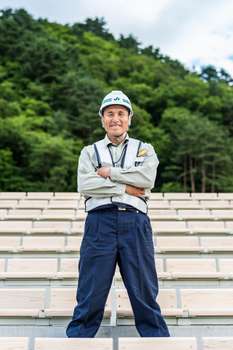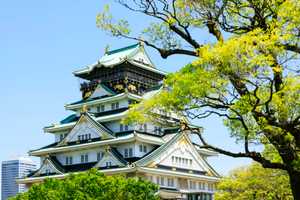
Tokyo Convention & Visitors Bureau Monocle / Global
Rugby World Cup 2019
As teams fine-tune their preparations ahead of next year’s tournament, now is the time to start planning your own sporting adventure.
Tokyo Convention & Visitors Bureau x The Monocle Forecast.
Tackling Tokyo
Kick-off
While in Tokyo, make time for cultural excursions and river cruises.
Host city: Tokyo
The Japanese capital is one of a dozen cities that will host matches and provide a gateway to some of the country’s famed regional attractions.
Old meets new
Tokyo’s dynamic mix of modern and traditional takes shape at Sumida Hokusai Museum. Designed by Kazuyo Sejima, the museum celebrates the work of renowned ukiyo-e artist Katsushika Hokusai. Integrated technology shines new light on Hokusai’s works, many of which were created by the renowned artist in his native Sumida City.








Venturing onto the streets of Sumida and east Tokyo reveals workshops producing a range of traditional wares. Dating back to the early 19th century, Edo Kiriko glassware features intricate patterns created through a series of cutting techniques. Craftspeople can be seen at work, while hands-on workshops provide an insight into their craft.
For a fresh view of Tokyo Skytree and the city’s evolving skyline, hop on board a yakatabune for an evening river cruise. Often adorned with glowing lanterns, the traditional boats provide the perfect setting to drink, dine and be entertained after dark.
Blurred lines
One of the latest additions to the city’s art scene is the imagination-filled TeamLab Planets Tokyo. Created by TeamLab, an interdisciplinary art collective based in Tokyo, the digital art space houses a collection of immersive installations and interactive works. Drawing on elements from nature and the universe, the works blur the lines between real and virtual, creating new ways for visitors to engage with art and the world around them.
Iwate/Kamaishi
This city is revered for its sporting success, sacred temples and saké breweries.
Rugby is woven into the fabric of the city of Kamaishi: the local Nippon Steel-backed team has won seven consecutive Japanese Rugby Football Championship titles from the late 1970s. The sport has also played a role in the city’s regeneration in the wake of the Great East Japan Earthquake. The host city bid committee included former Kamaishi and Japan national team player Jiro Ishiyama, who worked on construction of the new Kamaishi Unosumai Memorial Stadium.
Kamaishi Daikannon
The sacred Kamaishi Daikannon gazes out toward the horizon from high above the Sanriku coastline. A worship hall, kannon statues and the Seven Gods of Good Fortune await inside, while views can be enjoyed from the observatory on the 11th and 12th floors.
Hamachidori Brewery
Hamachidori has been producing fine saké for almost a century. Guided tours can be arranged and provide an insight into the brewery’s inner workings, including the creation of the award-winning Hamachidori Daiginjo.
Tournament map
Field view
Teams from all around the world will face off in 12 Japanese cities
Host cities
The seven-week tournament will commence with the kick-off match between Japan and Russia on 20 September in Tokyo. Matches will take place in 12 cities, at venues including the purpose-built Kamaishi Unosumai Memorial Stadium and the International Stadium Yokohama, where up to 72,000 fans are expected to be in situ for the final on 2 November.
See gallery for the Rugby World Cup 2019 map of Japan

Sapporo
The capital of the hilly northern island of Hokkaido is most famous for its beer and scenic skiing.
Sapporo Food Culture
Whether it’s fresh crab or zangi (deep-fried chicken), Sapporo brings together the unique flavours of the north. Inspect the catch of the day at the morning markets but save some room for a hearty bowl of soup curry, fresh dairy products and a medley of regional ramen.

Saitama/Kumagaya
Two rivers – the Arakawa and the Tone – flow through Kumagaya, a city in Saitama prefecture.
Shodenzan Temple
Kumagaya developed as a post town on the historic Nakasendo route from Tokyo to Kyoto and is home to Shodenzan Temple. Attracting those in search of good connections, the temple includes an opulent hall detailed with sculptures and is designated as a national treasure.

Kanagawa/Yokohama
Yokohama, the capital of Kanagawa prefecture, is known for the botanical oasis of Sankeien Garden.
Sukiyaki
The port city of Yokohama, selected to host the World Cup decider, is also the birthplace of sukiyaki. Originally known as gyu-nabe (beef hot pot), the dish has evolved but remains at the top of menus throughout the city, from waterfront restaurants to cosy small-scale venues.

Kobe
The capital city of Hyogo prefecture, on the north shore of Osaka Bay, is well known for its marbled beef.
Kobe beef
The origins of Kobe’s renowned beef are said to date back to the port’s opening to foreign trade, when an intrepid Englishman sampled the local Tajima beef. Today the city’s chefs present the marbled, melt-in-your-mouth delicacy in myriad ways.

Fukuoka
A thoroughly modern city and the largest on the island of Kyushu, off the south coast of mainland Japan.
Dining in Tenijn
The bustling streets of Tenjin provide a crash course in Fukuoka cuisine. Local dishes include Hakata ramen, mentaiko (pollock roe) and mizutaki (chicken hot pot). For an intimate insight into the food scene, pull up a seat at one of the local yatai (food carts).

Kumamoto
Kumamoto is the capital city of Kumamoto prefecture, located at the centre of Kyushu.
Daikanbo
One of the world’s biggest calderas – a form of volcanic crater – is found in the fields of Daikanbo. Gairin Mountain surrounds the five peaks of Aso-Gogaku and the crater basin, and it’s said by some that Aso-Gogaku resembles oshakasama, or a sleeping buddha.

Shizuoka
On central Honshu’s Pacific coast, Shizuoka prefecture is home to Mount Fuji and hot spring resorts.
Mount Fuji
No trip to Shizuoka would be complete without a visit to Japan’s most iconic peak. Beautiful views of Mount Fuji, which has been designated as a World Heritage Site, can be seen from the scenic area of Miho no Matsubara, a seven-kilometre shore lined with trees.

Aichi/Yoyota
Aichi is located in central Japan and is home to ceramic and automobile manufacturing facilities.
Seto
Home to one of Japan’s Six Ancient Kilns, Seto’s history of ceramic production dates back more than 1,000 years. The local Seto ware is made using various glazes and techniques including sometsuke, which results in underglaze paintings in blue on a white porcelain base.

Osaka/Higashi-Osaka
Higashi-osaka, located in Osaka prefecture, is well known for rugby and manufacturing.
Osaka Castle
Standing at the centre of Osaka Castle Park, Tenshukaku is a history museum that appears to have five levels from the outside but, inside, reveals eight. The park itself contains many historical sites and is a peaceful oasis in a city that
offers plenty of pleasant greenery.

Oita
Famous for its onsen cities, Oita prefecture is located on the eastern coast of Kyushu Island.
Hells of Beppu
With names like Oven Hell and Tornado Hell, this group of hot springs provides a glimpse into Beppu’s geothermal wonders. After checking out these sightseeing spots, relax and recharge with a round of bath-hopping in the eight hot spring areas found in the city.

Miyagi
Miyagi is a Japanese prefecture north of Tokyo on the east coast of Honshu Island.
Sendai
The economic hub of the Tohoku region boasts a rich history, natural beauty and inspiring architecture. From the opulent Zuihoden mausoleum and its lush surrounds to the zelkova-lined promenade of Jozenji Street, the scenic city lives up to its “City of Trees” moniker.

Fukushima
Fukushima, the southernmost prefecture of the Tohoku region, offers ample natural beauty.
Abukuma Cave
Located in the Abukuma Highlands, this limestone cave was discovered by chance during excavation. Taking shape over more than 80 million years, the cave is renowned for its vast array of stalactites and for its cavernous main hall, known as the Takine Palace.

For more information visit sportsjourney.jp.


